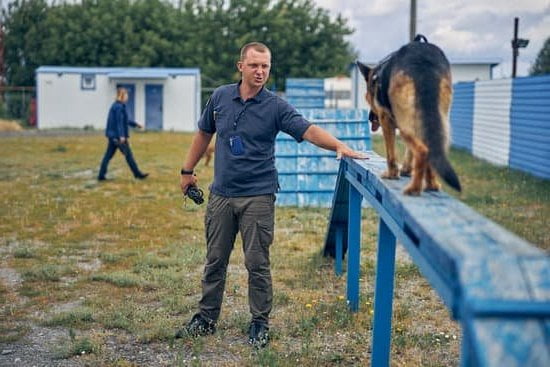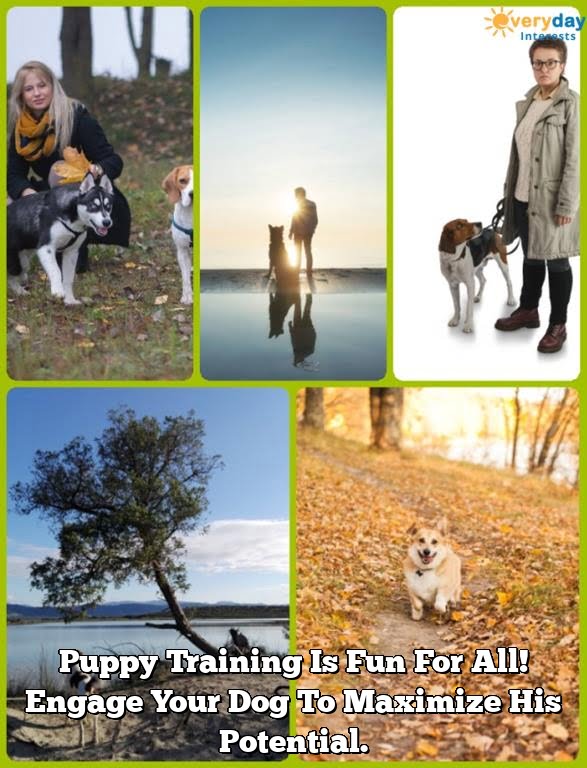Are you struggling to make training enjoyable for your furry friend? In this article, we will explore the key strategies on how to make training fun for your dog. Understanding your dog’s behavior and learning style is crucial in creating an engaging training experience. By incorporating play into training sessions and using positive reinforcement techniques, you can ensure that your dog not only learns effectively but also has a great time doing so.
Dogs, like humans, have their unique personalities and preferences when it comes to learning. It’s essential to tailor your training approach to suit your dog’s needs and interests. This section will delve into the importance of understanding your dog’s behavior and learning style, providing valuable insights into how you can make the training process enjoyable for both you and your canine companion.
In addition to traditional obedience exercises, incorporating play into training sessions can significantly enhance your dog’s enthusiasm for learning. We will explore various interactive games and activities that not only reinforce desired behaviors but also strengthen the bond between you and your pet. With these tips, you can transform mundane training sessions into exciting and enjoyable experiences for your dog.
Understanding Your Dog’s Behavior and Learning Style
Observing Your Dog’s Behavior
It is crucial to understand that every dog is unique, and their behavior can vary based on several factors such as breed, age, and personality. Take the time to observe your dog’s behavior in different situations to gain insight into their learning style and what motivates them. This can help you tailor your training approach to best suit your dog’s individual needs.
Learning Style Differences
Just like humans, dogs have different learning styles. Some may be more food-motivated, while others may respond better to play or verbal praise. By understanding your dog’s learning style, you can adapt your training techniques to make them more effective and enjoyable for your pet.
Creating a Positive Environment
When trying to figure out how to make training fun for your dog, consider their comfort level in the training environment. Ensure that the space is free from distractions and creates a positive atmosphere for learning. This will help your dog feel at ease and more willing to engage in the training process.
Understanding your dog’s behavior and learning style is essential in making training sessions enjoyable for both you and your pet. By observing their behavior, recognizing their unique learning style, and creating a positive environment for training, you can tailor your approach to best meet your dog’s individual needs and make the entire process fun for them.
Incorporating Play Into Training Sessions
First, consider using toys as a reward during training. Many dogs are highly motivated by toys, so using them as a reward can make the training process more engaging for your dog. For example, if you are teaching your dog to fetch or retrieve an item, incorporating their favorite toy as a reward can make the activity more enjoyable for them.
Another way to incorporate play into training sessions is to use interactive games such as hide and seek or tug-of-war. These games not only provide mental stimulation for your dog but also serve as a form of positive reinforcement during training. By making the training process feel like a game, you can keep your dog engaged and excited about learning new behaviors.
Finally, consider incorporating play breaks into longer training sessions. Just like humans, dogs can become fatigued during long periods of focused training. Incorporating short play breaks allows your dog to relax and recharge before continuing with their training. This not only makes the overall experience more enjoyable for them but also helps maintain their focus and enthusiasm throughout the session.
By incorporating play into your dog’s training sessions, you can make the process more enjoyable, engaging, and rewarding for both you and your canine companion. Remember that every dog is unique, so experiment with different types of play to find out what works best for your furry friend.
Using Positive Reinforcement Techniques
When it comes to training your dog, using positive reinforcement techniques can be highly effective and enjoyable for both you and your furry friend. Positive reinforcement involves rewarding your dog for good behavior, which encourages them to repeat that behavior in the future.
This creates a happy and fun environment for training, making it more likely that your dog will be engaged and eager to learn. Here are some positive reinforcement techniques that you can use to make training fun for your dog:
1. Treats: Using treats as a reward is a classic form of positive reinforcement. When your dog successfully follows a command or exhibits good behavior, give them a treat as a reward. This will create a positive association with the command and encourage your dog to perform it again in the future.
2. Verbal praise: Dogs thrive on praise from their owners, so using verbal cues such as “good boy” or “good girl” can be highly motivating for them. Showering your dog with verbal praise when they do something right will make them feel good and reinforce their good behavior.
3. Playtime: Incorporating play into training sessions is a great way to use positive reinforcement. After your dog successfully completes a task, engage in some playtime with their favorite toy as a reward. This not only reinforces their training but also provides an opportunity for bonding and enjoyment.
By utilizing these positive reinforcement techniques, you can create an enjoyable and effective training experience for your dog. Remember to keep the training sessions short, frequent, and consistently rewarding in order to maintain your dog’s interest and enthusiasm. Ultimately, by making training fun for your dog, you’ll strengthen the bond between you and ensure that they look forward to learning new commands and behaviors.
Making Training Interactive and Engaging
When it comes to training your dog, it is important to make the process as interactive and engaging as possible. Dogs are intelligent and social animals, and they thrive on mental stimulation and human interaction. By incorporating interactive elements into their training sessions, you can keep them engaged and motivated to learn.
One way to make training interactive is by using games and activities that challenge your dog both mentally and physically. For example, you can teach them to fetch specific items or navigate through an agility course. These types of activities not only help with obedience training but also provide a fun way for your dog to burn off excess energy.
Another effective way to make training more engaging is by incorporating problem-solving exercises. For instance, hiding treats around the house or in the backyard and teaching your dog to find them can be a great way to stimulate their mind while reinforcing good behavior. These types of activities tap into your dog’s natural instincts and provide them with a sense of accomplishment when they successfully complete the task.
Additionally, using interactive toys such as puzzle feeders or treat-dispensing devices can make training sessions more enjoyable for your dog. These toys not only provide mental stimulation but also encourage independent play, which can be particularly beneficial for high-energy dogs.
By making training interactive and engaging, you can create a positive learning environment for your dog while strengthening your bond with them. This approach not only promotes obedience but also ensures that both you and your furry friend have fun in the process of learning new skills.
Scheduling Short and Regular Training Sessions
When it comes to training your dog, consistency is key. One of the best ways to make training fun for your dog is by scheduling short and regular training sessions. Dogs have short attention spans, so keeping training sessions brief can help prevent them from getting bored or frustrated. It’s also important to schedule these sessions regularly to reinforce good behavior and keep your dog engaged in the learning process.
A good rule of thumb is to keep training sessions no longer than 10-15 minutes at a time, several times a day. This will prevent your dog from becoming overwhelmed and help maintain their focus. By keeping sessions short and sweet, you can make the most out of each training session and avoid burnout for both you and your furry friend.
In addition to ensuring that training sessions are short and regular, it’s also important to pay attention to your dog’s energy levels. Some dogs may be more responsive in the morning, while others may be more alert in the evening. By scheduling training sessions at optimal times for your dog, you can maximize the effectiveness of each session and make the experience more enjoyable for them.
| Key Point | Details |
|---|---|
| Scheduling Sessions | Keep them short (10-15 minutes) several times a day |
| Timing | Schedule sessions at optimal times for your dog’s energy levels |
Incorporating Training Into Daily Activities
Walks as Training Opportunities
Taking your dog for a walk is not just an opportunity for exercise, but also a chance to incorporate training into daily activities. Use the time during walks to practice commands such as “sit,” “stay,” and “heel.” Bring along some treats and use positive reinforcement to reward good behavior. This will not only make the walk more enjoyable for your dog, but it will also reinforce their training in real-life situations.
Mealtime Training
Another daily activity that can be turned into a training opportunity is mealtime. Instead of simply placing your dog’s food bowl on the ground, use mealtime as a chance to work on obedience and impulse control. Ask your dog to perform a command such as “sit” before they are allowed to eat. This simple exercise can help reinforce their training and create a routine that makes mealtimes more engaging for your pet.
Interactive Toys and Games
Integrating training into daily activities can also involve interactive toys and games. Puzzle toys that dispense treats or games of hide-and-seek with toys can provide mental stimulation and reinforce training commands while allowing your dog to have fun. Incorporating these activities into your daily routine not only strengthens the bond between you and your pet but also makes training an enjoyable part of their day-to-day life.
By integrating training into daily activities, you are creating opportunities for consistent reinforcement and growth while making the process enjoyable for both you and your dog. These small, regular activities can go a long way in keeping your pet engaged and well-behaved, ultimately leading to a happier and more well-adjusted furry friend.
Enrolling in Dog Training Classes or Workshops for Socialization and Fun
Enrolling your dog in training classes or workshops can be a great way to make training fun for your furry friend. These classes not only provide structured learning but also offer opportunities for socialization and interaction with other dogs. Here are some benefits of enrolling in dog training classes for both you and your pet:
- Learning from Professional Trainers: Dog training classes are typically led by experienced professionals who can provide valuable insights and guidance on how to make training fun for your dog. They can teach you effective techniques and strategies to engage your dog during the training process.
- Socialization Opportunities: Enrolling in training classes allows your dog to interact with other pets, which is essential for their social development. It can help them learn how to behave around other animals and humans, making them more well-adjusted and sociable companions.
- Structured Environment: Training classes provide a structured environment that can benefit both you and your dog. They offer a dedicated space for learning, minimizing distractions and creating a conducive atmosphere for effective training.
Moreover,/ Additionally,/ Furthermore, many training classes incorporate interactive games and activities into their curriculum, making the learning process enjoyable for your dog. These activities stimulate their minds, keep them engaged, and create a positive association with the training experience.
By enrolling in these classes, you not only provide your dog with essential skills but also create an opportunity for bonding and enjoyment between the two of you. It’s a win-win situation that can make the training process more rewarding for both parties involved. So if you’re wondering how to make training fun for your dog, consider enrolling in a reputable dog training class or workshop near you.
A Case Study
Training a stubborn dog can be challenging, but with the right approach, it can also be incredibly rewarding. When it comes to how to make training fun for your dog, incorporating play and positive reinforcement techniques is key. One case study that highlights this approach is the successful fun training with a stubborn dog named Max.
Max, a strong-willed and independent German Shepherd, was initially resistant to traditional training methods. However, his owner discovered that integrating play into training sessions made a significant difference in Max’s response. By using toys and games as rewards for good behavior, Max became more engaged and motivated during training.
In addition to incorporating play, using positive reinforcement techniques such as treats and verbal praise was crucial in shaping Max’s behavior. These methods helped build a strong bond between Max and his owner, making the training process enjoyable for both parties. By focusing on rewarding desirable behaviors rather than punishing unwanted ones, the training sessions became more effective and enjoyable for Max.
Overall, the case study of successful fun training with Max demonstrates how understanding a dog’s behavior and learning style is essential in achieving positive outcomes. By using play, positive reinforcement, and patience, even stubborn dogs like Max can become enthusiastic learners.
| Training Approach | Impact on Stubborn Dog |
|---|---|
| Incorporating play | Increased engagement and motivation |
| Positive reinforcement techniques | Building a strong bond with the owner |
Conclusion
In conclusion, making training fun for your dog is not only beneficial for their behavior and development but also for strengthening the bond between you and your furry friend. By understanding your dog’s behavior and learning style, incorporating play into training sessions, using positive reinforcement techniques, and making training interactive and engaging, you can create an enjoyable and effective training experience for both you and your dog.
When scheduling short and regular training sessions, as well as incorporating training into daily activities, you can further reinforce their learning while keeping things fun and exciting. Additionally, enrolling in dog training classes or workshops can provide socialization opportunities for your dog while also making the entire process more enjoyable.
Ultimately, the key to successful fun training with your dog lies in patience, consistency, creativity, and a positive attitude. By enjoying the process of training your dog and celebrating their progress along the way, you will not only have a well-behaved pet but also a strong and loving relationship with them. So go ahead, get creative with how to make training fun for your dog – it will be worth it.
Frequently Asked Questions
How Can I Make My Dog Training Class Fun?
Making your dog training class fun can be achieved by incorporating games and interactive activities into the training sessions. Using positive reinforcement, such as treats and praise, can also make the experience enjoyable for your dog.
How Do I Keep My Dog Training Interesting?
To keep your dog training interesting, you can vary the exercises and commands you teach to prevent boredom. Introducing new challenges and environments, as well as using different rewards, can help maintain your dog’s engagement during training.
What Are the 7 Commands to Train a Dog?
The 7 basic commands to train a dog are: sit, stay, come, down, heel, off (or leave it), and no (or stop). These commands are essential for effectively communicating with your dog and establishing obedience and good behavior.

Welcome to the blog! I am a professional dog trainer and have been working with dogs for many years. In this blog, I will be discussing various topics related to dog training, including tips, tricks, and advice. I hope you find this information helpful and informative. Thanks for reading!





